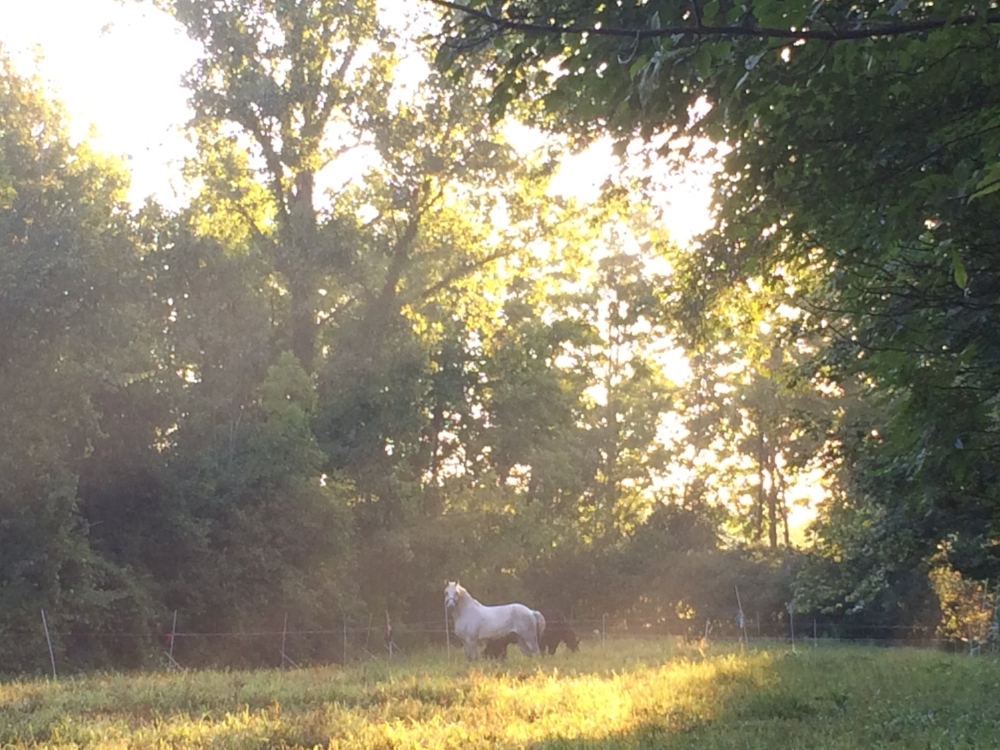How We Farm
At Featherbed Lane Farm, we strive to run a successful farm business that produces nutritious foods while building our soils, caring for our livestock, stewarding our land, respecting our employees and contributing to our community.
Ideally, farming can be done in a way that balances agricultural production with the maintenance of soil and water quality, wildlife diversity, farmworker rights and health, economic conditions and community development. There is not one best way to farm, rather it is an evolution that needs to account for context. We see it as an always changing pursuit, to farm well. We invite you to learn more, ask questions and be a part of doing the best we can here at Featherbed Lane Farm.
Draft horses
A defining feature of our farm is our work with draft horses. While human powered systems tend to be the most technically efficient, draft animal power and smaller engines are the next best.
In part, I work with draft horses because I like that their food can be grown on the farm, or nearby, and that their waste (manure) is a valuable product for fertility. Draft horses can also cause less soil compaction than tractors, which benefits the flow of water and nutrients in the soil and supports a healthier soil biology. That said, it's important to note that one can farm well or poorly with draft horses, just as one can farm well or poorly with a tractor. We aim to use draft horse power here at Featherbed Lane Farm to produce the best quality of food while also improving soil health.
The main reason for why I farm with draft horses is I enjoy the process of working, learning, communicating and growing with them. In short, I farm with draft horses because I love doing it.
COVER CROPS, COMPOST, MANURE & IRRIGATION
Cover crops are plants grown in a field to support the field's health rather than for their own harvest. The use of cover crops - such as legumes, buckwheat and tillage radish - builds soil organic matter, suppresses weeds, addresses nutrient deficiencies, and improves the soil's drainage and tilth.
Manure and compost are very valuable soil amendments. Particularly when combined with cover crops, manure and compost are integral to any long-term and balanced approach to soil health. Manure is sometimes applied fresh to pasture or hay fields, or to vegetable fields that are in fallow, but we primarily apply manure that has been composted for up to or over a year. In our compost piles, we mix in bedding from horse stalls, vegetable scraps, wood ash and other organic materials.
Irrigation in the fields can be critical to ensure crop health and quality. However, we prefer to irrigate as little as possible. Our preference is to build up a high level of organic matter and to select for crops that do well under less coddled conditions. When we do irrigate, we aim for efficient and targeted use of water to benefit the crops and soils and to suppress the weeds.
Plants and livestock - Diversity and ROTATIONS
We grow a diversity of crops and raise a diversity of livestock on the farm. We rotate when and where these crops are grown and when and where the animals pastured, both within a year and from year to year.
Diversity and rotations help to avoid or diminish pest pressures as well as maintain and increase soil health and animal health. Another benefit of on-farm diversity and rotations is they create conditions for healthier crops, which leads to increased yields.
Diversity and rotations are also employed to minimize or completely remove the use of pesticides and herbicides. In general,we try to use neither of these products. When they are used, we use them sparingly, in consideration of the National Organic Standards and in conjunction with more biological controls and Integrated Pest Management practices. We, our employees, everyone eating the farm's produce, the farmscape and the farm’s bottom line all benefit from avoiding or minimizing their use.
AGROFORESTRy, SILVOPASTURE and Habitat management
Agroforestry is a term that encompasses the production of forest crops, such as tree harvests or maple syrup production as well as mushrooms, wild leeks and more. Initial agroforestry production at Featherbed Lane Farm will focus on harvesting and managing for wild edibles in the farm's forests. Over time, mushrooms, ginseng and other forest crops and products will be added.
Silvopasture is a practice that combines forest management with livestock grazing. We are in the very early stages of developing a silvopasture plan for the farm, with the triple goal of removing invasive species, improving habitat and providing great grazing opportunities for our livestock - likely pigs, goats and/or sheep.
Habitat management is very important to us at Featherbed Lane Farm. Agroforestry and silvopasture, as well as open field farm production, can all be done in ways that benefit wildlife while also yielding great food. Wherever possible, we will work to integrate habitat management into our farm production practices. We will be planting wildflowers and in other ways encouraging populations of pollinators and other beneficial wildlife. Other habitat management practices will include the management of hedgerows and forest edges to provide shelter for wildlife while also serving as food sources for livestock and wind breaks that benefit crops and farm structures. We will also manage habitat for habitat's sake. And we will be improving the farm's trail networks as well as offering guided nature walks and other on-farm events so that our CSA members can enjoy the wildlife that calls Featherbed Lane Farm home.


